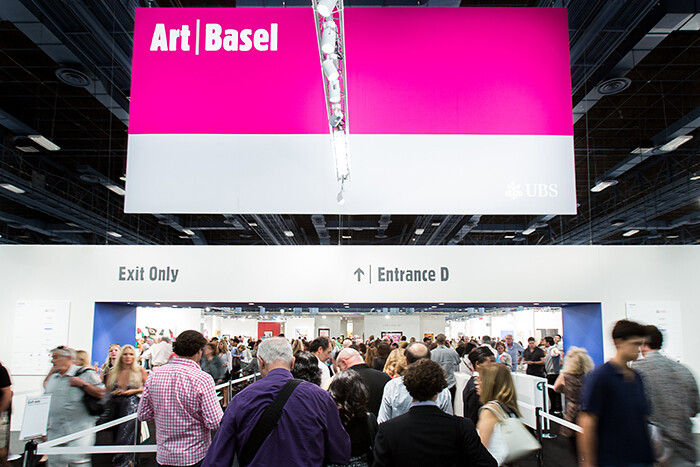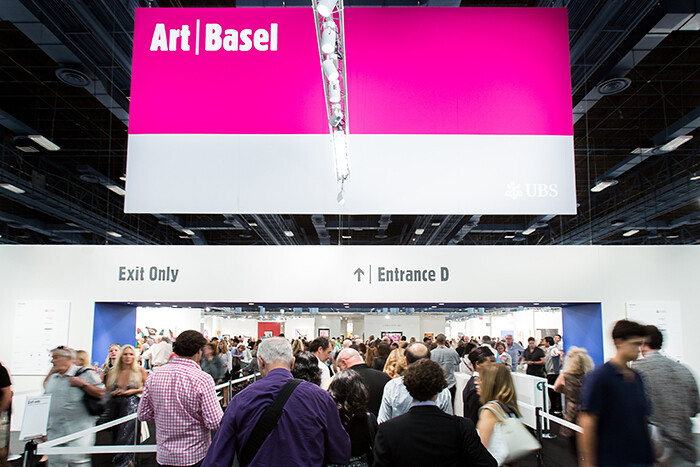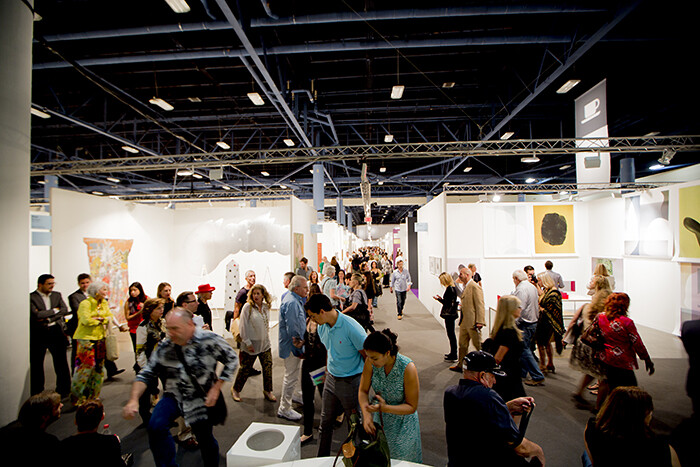Within sixty seconds of walking into the Miami Beach Convention Center, I had already seen two White Men Wearing Google Glass1—a new, supremely annoying demographic fitting seamlessly into the obnoxious displays of wealth that have long characterized Art Basel Miami Beach. Admittedly, there isn’t much surprising about the presence of the “Glassholes”: the 2013 edition of the fair saw the same privileged white guys, the same big, bad, dumb, shiny art, the same über-high heels complementing the same über-short skirts as previous years. While an eternal cycle repeated itself—new crops of hot, young artists were ushered in and yesteryear’s artists ushered out—perhaps what was really new was the return of overwhelmingly positive sales reports pouring in from Art Basel and the so-called “indie” fairs. “The flow of new people coming into the market and the scene keeps growing,” reports Josh Baer in his December 6th Baer Faxt dispatch. Adding to the feeding frenzy, he claims, is the fact that young artists are getting picked up and “hundreds of collectors are chasing a limited inventory—so these works at the fair might have 50 people asking to buy them.”2
Signal the alarm, raise the flag from half-mast: we are officially in the throes of a ravenous art market fully recovered from 2008’s economic downturn. Rich people, it is rumored, are getting richer, and looking for more liquidities within which to hide their dosh. “What’s more liquid than cash? Art!” a friend exclaimed as we were surveying the fair. “Art is easier to ship across boundaries than cash, it wasn’t on the brink of collapse a year ago as was the Euro, it’s not real estate that will sink into the ocean in a few decades, and it’s not even subject to inheritance tax.” No wonder hordes of new collectors are rallying up to the trough: the art market is neoliberalism’s best kept non-secret!
One question remains: Why wax philosophical on bringing the pigs to the market? It’s almost comical to think about the function of discursive programming in the broader commercial context of the art fair. Clearly, these programs—and especially the Talks—provide a vain, intellectual lubricant for the rash-inducing, transactional bacchanal that is Art Basel. Nevertheless, it’s a sad but true fact that it takes a cash-rich juggernaut like Art Basel to facilitate ambitious events and programming, and overall the Talks program and the Film sector (organized by Artprojx’s David Gryn and Swiss curator This Brunner) were winningly assembled. As in the case of previous years, Art Basel’s talks were divided into “Conversations” occurring every morning at 10 a.m., which were free and open to the public, and “Salon” events, which took place throughout the day and required a forty-two-dollar entrance ticket to attend. Generally, the morning offerings were much more populated, and seemingly attended by tourists and Miami locals—judging by the plethora of pastels and Day-Glo colors and the lack of black clothing signaling hungover art-worlders.
Saturday morning’s main conversation, “The Artist and the Gallerist,” paired artist Abraham Cruzvillegas and Jose Kuri of kurimanzutto gallery—both hailing from Mexico City—for a surprisingly intimate discussion moderated by Mark Rappolt, editor of ArtReview. The duo spoke about the evolution of their professional and personal relationship over the past twenty years, with Rappolt frequently asking Kuri playfully probing questions such as: “Are you jealous when Abraham has a great exhibition with another gallery?” (The answer is yes), and “What happens if you say ‘no’ to something that Abraham asks you for? Does he ask [Kuri’s wife and kurimanzutto co-founder] Monica?” (Apparently, he gets jealous about that too). While the conversation was unusually enlightening, funny, and heartening, the ensuing question-and-answer session was a huge downer. A series of earnest, naive, and cringe-inducing questions from the audience (i.e. “How do I find a gallerist?”) served as a prescient reminder of just how far divorced the Art Basel Miami Beach conception of contemporary art is from that of the general public.
Less well-attended than the Conversations, but perhaps one of the more fruitful, albeit characteristically insidery discussions, was the Saturday Salon session “Shifting Scale in New York Arts Institutions,” moderated by the robotically articulate and almost humorously impeccably prepared Triple Canopy director Peter J. Russo. The panel members considered the changing landscape of the contemporary art institution in New York—its funding structures and responsibilities. While the conversation evinced the roles that influential, young cultural figures have at their respective institutions—Allison Freedman Weisberg leaving the museum world to establish the small, Soho-based collaborative non-profit Recess; Ruba Katrib leading the refreshingly feminist-inflected programming at Long Island City’s SculptureCenter; and Miriam Katzeff producing (with co-founder James Hoff) large-run, inexpensive artist books at Primary Information—perhaps the talk’s most inspirational sentiment came from Katrib, who noted that the history of New York alternative spaces is largely dominated by women.3, Marcia Tucker starting the New Museum, etc.] The panel didn’t produce much macro-level analysis of this phenomenon, but it provided such open-ended fodder that I was left in the increasingly unusual situation that I didn’t want the panel to end.
Featuring this year’s brightest and youngest things was the Salon’s “89plus Panel Discussion,” amended with the curious label “Focus: Branding.” It featured artists Brian Khek and Amalia Ulman, writer Kevin McGarry, and was moderated by Dena Yago and Sean Monahan of K-HOLE, a trend forecasting group that could also be described as an art project. “89plus” is a “long-term, international, multi-platform research project” co-founded by the newly-hired Swiss Institute director and curator Simon Castets, himself also very bright and young, and everyone’s favorite omniscient, omnipresent polyglot curator Hans Ulrich Obrist. If you pay any attention to art fair talks, you’ve probably heard about “89plus,” and may—admittedly, like myself—be confused about its purview and functionality. The platform purports to highlight and support the efforts of the generation born after 1989 (this year marking the fall of the Berlin Wall and the dissolution of communism in Central and Eastern Europe, in addition to Tim Berners-Lee’s invention of the World Wide Web), though the only panelists on stage born on or after 1989 were Khek and Ulman. The panel more or less introduced the practices of the participating cultural practitioners, the unstated, underlying motif of the conversation being that those born after 1989 had some claim to digital nativity.
Yet, it should be considered whether this generation has any enlightening relationship to living in networked society. If “89plus” mainly investigates our acclimation to the internet and advanced digital technology, then an individual’s adoption of it—and the rate and fluency with which one uses technology—should also be a deciding factor until we eclipse a generation that cannot objectively think past the time hand-held, smartphone technologies were introduced to society—say those born in 2007, the year of the iPhone’s introduction to the consumer market. Clearly, the impulse to fetishize and homogenize young generations is nothing new—and also usually nothing worthwhile or pretty—and despite Obrist and Castets’ purported intellectual legwork, generational labels remain one of the oldest branding strategies in the book. Though Castets seemed adamant to dispel in advance the critique that “89plus” rides on the youth of its participants, that the discussion took place in the context of an art fair, where youth is a form of currency, provided a strong dose of cognitive dissonance. This is exactly the sort of insidious intellectual veneer endemic to supplemental programming that gets us drunk on the new and gives collectors the green light.
Perhaps more reflective on our relationship to technology was Obrist’s subsequent Conversations panel “Artist as Technologist,” which took place on the final day of the fair and convened the comparably “older” artists Camille Henrot, Cécile B. Evans, Cory Arcangel, and art and tech godfather Robert Whitman, who founded Experiments in Art and Technology (E.A.T.). Mostly comprising presentations on the participants’ work with some of Obrist’s famous moderated Q&A, the panel looked both forward and back, examining lineages in art and technology largely beginning with the ever-important E.A.T. While informative, the panel missed the opportunity to contemplate the political responsibility of the artist as a technological ambassador to the public: if artists are early adopters of technology and are charged with contextualizing its use in contemporary society, why does it remain such an unpopular topic of inquiry to consider advanced technology’s less obvious sociopolitical effects? Please, someone educate us about the privacy policies of Facebook, surreptitious data mining practices, or the actual physical stuff that makes up the internet and its geography-dependent politicization. While cultural producers and writers including Metahaven, Hito Steyerl, Lance Wakeling, and Tyler Coburn have considered these questions, perhaps such muddy topics aren’t sexy enough for an Art Basel talk.
In a moment of characteristic sagaciousness, when asked by Obrist about why he often employs older technology in his work, Arcangel replied, “I don’t see really see the difference between old technology and new technology. New technology will be old in three years anyway, so ideologically it’s basically the same. Why not use the old junk laying around that no one wants?” It could be argued, coincidentally, that the same life cycle applies to artists and art fair trends—if only we could have Arcangel’s perspicacity to know that we are always on one side of a swelling or subsiding tide.
The demographic has even inspired a rather sardonic Tumblr (fittingly titled “White Men Wearing Google Glass”): http://whitemenwearinggoogleglass.tumblr.com/.
Josh Baer, “Miami Report,” The Baer Faxt, Issue #107, December 6, 2013.
A few of note: Alanna Heiss initiating PS1 Contemporary Art Center, Thelma Golden directing the Studio Museum in Harlem, Dorothea Denslow launching SculptureCenter [formerly “The Clay Club”










